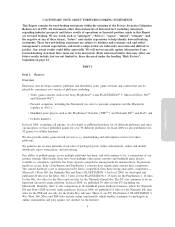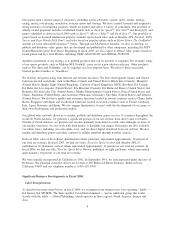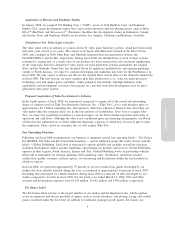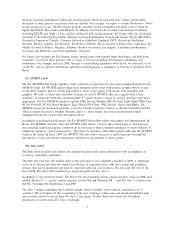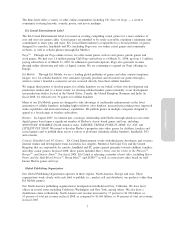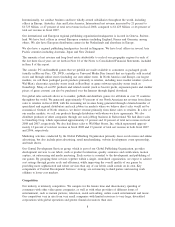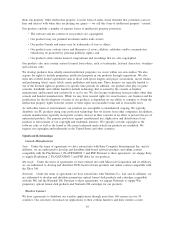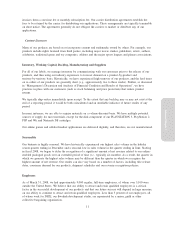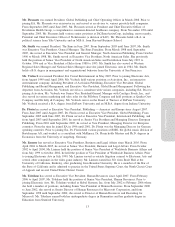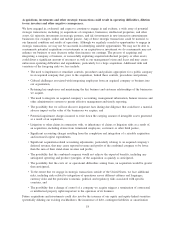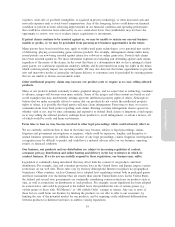Electronic Arts 2008 Annual Report Download - page 85
Download and view the complete annual report
Please find page 85 of the 2008 Electronic Arts annual report below. You can navigate through the pages in the report by either clicking on the pages listed below, or by using the keyword search tool below to find specific information within the annual report.
We also face heavy competition from other video game companies and large media companies to obtain
license agreements for the right to use some of the intellectual property included in our products. Some of
these content licenses are controlled by the diversified media companies, which, in some cases, have decided
to publish their own games based on popular entertainment properties that they control, rather than licensing
the content to a video game company such as us.
Competition in Sales of Packaged Goods
Our packaged goods business is characterized by the continuous introduction of innovative new titles and the
development of new technologies. Competition is also based on product quality and features, timing of product
releases, brand-name recognition, availability and quality of in-game content, access to distribution channels,
effectiveness of marketing and price.
For sales of packaged goods, we compete directly with Sony, Microsoft and Nintendo, each of which develop
and publish software for their respective console platforms. We also compete with numerous companies which,
like us, develop and publish video games that operate on these consoles and on PCs and handheld game
players. These competitors include Activision, Atari, Capcom, Koei, Konami, LucasArts, Midway, Namco,
Sega, Take-Two Interactive, THQ and Ubisoft. Diversified media companies such as Fox, Disney, Time
Warner, Viacom and Vivendi are also expanding their software game publishing efforts.
Competition in Sales for Cellular Handsets
The wireless entertainment applications market segment, for which we develop and publish games, ring tones,
music, video and wallpapers for cellular handsets, is highly competitive and characterized by frequent product
introductions, rapidly evolving wireless platforms and new technologies. As demand for applications continues
to increase, we expect new competitors to enter the market and existing competitors to allocate more resources
to develop and market competing applications. As a result, we expect competition in the wireless entertainment
market segment to intensify.
Current and potential competitors in the wireless entertainment applications market segment include major
media companies, traditional video game publishing companies, wireless carriers, wireless software providers
and other companies that specialize in wireless entertainment applications. We also compete with wireless
content aggregators, who pool applications from multiple developers (and sometimes publishers) and offer
them to carriers or through other sales channels. In addition, new and existing competitors are beginning to
offer wireless entertainment applications on an ad-supported basis. Currently, we consider our primary
competitors in the wireless entertainment applications market segment to be Disney, Fox Mobile Entertain-
ment, Gameloft, Glu Mobile, Hands-On Mobile, Namco, Sony Pictures and THQ Wireless.
Competition in Online Gaming Services
The online games market segment is also highly competitive and characterized by frequent product introduc-
tions, new and evolving business models and new platforms. As the proportion of households with a broadband
connection continues to grow, we expect new competitors to enter the market and existing competitors to
allocate more resources toward developing online games services. As a result, we expect competition in the
online games services market segment to intensify.
Our current and potential competitors in the online games market segment include major media companies,
traditional video game publishing companies, and companies that specialize in online games. In the massively
multiplayer online game business our competitors include Atari, Midway, NC Soft, Sony and Vivendi Games.
Competing providers of other kinds of online games include MSN, Popcap, Real, AOL, Yahoo! and Nexon.
Intellectual Property
Like other entertainment companies, our business is significantly based on the creation, acquisition, exploita-
tion and protection of intellectual property. Some of this intellectual property is in the form of software code,
patented technology, and other technology and trade secrets that we use to develop our games and to make
Annual Report
9






